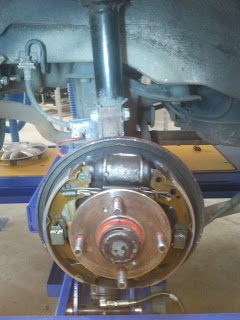Drum brakes today are commonly found as the standard set up for rear or park brakes. They offer very good braking and are naturally stronger than caliper brakes. They have a set of brake shoes which rub on the inside of a brake drum, and are pulled back together with springs. The force that pushes the shoes apart and towards the inner of the drum is a brake drum cylinder, which builds up with pressure as the foot brake is applied. A parking brake cable is also connected to the assembly, which pulls on the other end of the levers. between the cable end and the cylinder ends of the levers, is the pivot point.
Servicing brake drums:
A typical vehicle servicing will involve checking the tightness of the park brake. Release the handbrake before the car is hoisted up into the air. After the wheel is removed, we give the drum a turn, the shoes should just be touching a little bit. Remove the brake drum. This may involve using an impact screw driver. Use an impact screw driver and a hammer. I generally spray the assembly with brake cleaner first to get rid of all the brake dust inside.
Check the dust seals by pulling them out slightly, to check if there is any fluid or dust in there. It should be clean inside. The dust seal is to protect the master cylinder from any dust that can come inside and damage the internal parts or get into the fluid. The tightness can be adjusted by using a small flat head screw driver, and giving it 'clicks'. You will notice the shoes moving slightly further apart. Put the drum back on after every 5-10 clicks, to make sure it's not over tightened. Over tightened drum brakes will begin to smoke while driving and completely wear out the shoes.
Different types of shoes are duplex, servo and simplex. Duplex is the more common one, while the other two may be found in heavier duty vehicles like trucks and vans.
Different types of shoes are duplex, servo and simplex. Duplex is the more common one, while the other two may be found in heavier duty vehicles like trucks and vans.
To replace the shoes, There are two pins per shoe, that are tensioned with springs. (similar to removing valve springs and valves). Push the springs down and twist, this will come off. The shoes will then come off.



No comments:
Post a Comment